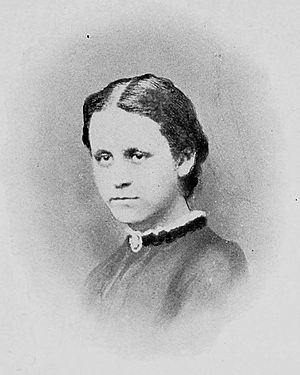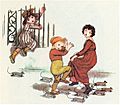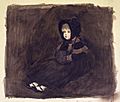Kate Greenaway facts for kids
Quick facts for kids
Kate Greenaway
|
|
|---|---|
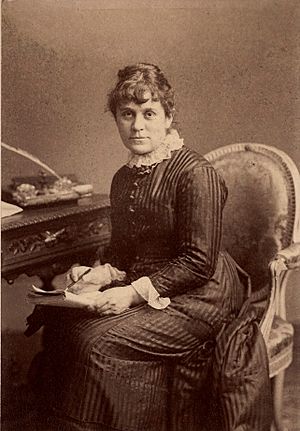 |
|
| Born |
Catherine Greenaway
17 March 1846 |
| Died | 6 November 1901 (aged 55) Frognal, London, England
|
| Nationality | British |
| Education | Heatherley School of Fine Art |
| Known for | Creation of picture books |
Catherine Greenaway (born March 17, 1846 – died November 6, 1901) was a famous English artist and writer from the Victorian era. She is best known for her beautiful illustrations in children's books.
Kate studied graphic design and art from 1858 to 1871 at several schools, including the Finsbury School of Art and the Royal College of Art. She started her career by designing popular holiday cards for Christmas and Valentine's Day. In 1879, a printer named Edmund Evans published her book, Under the Window. It became an instant bestseller and made her very famous. She continued to work with Evans for many years.
Her pictures of children wearing imaginary 18th-century costumes became incredibly popular. This unique style was known as the "Kate Greenaway style." Soon, artists in England, Germany, and the United States began to copy her work.
Contents
Early Life and Inspirations
Kate Greenaway was born in Hoxton, London. She was the second of four children in a working-class family. Her mother, Elizabeth, was a dressmaker, and her father, John, was an engraver.
When Kate was very young, her father took a job illustrating a new edition of Charles Dickens's The Pickwick Papers. To focus on his work, he sent his family to stay with relatives in the countryside. Kate's earliest memories were of Rolleston, Nottinghamshire, which she loved deeply. She visited Rolleston often during her childhood. It became a special place in her mind, a "country of the mind" that she would often imagine and add details to.
After returning to busy London, Rolleston remained a comforting memory. It was a place she could always visit in her thoughts.
When her father's publisher went bankrupt, the family lost their income. Kate's mother opened a children's dress shop in Islington, which attracted wealthy customers. The family lived above the shop. Young Kate spent many hours exploring the enclosed courtyard garden. She later wrote about it as a place full of "richness of colour and depth of shade."
Her father often worked late into the night, engraving for weekly newspapers like The Illustrated London News. Kate enjoyed watching him work. Through his illustrations, she saw the art of famous illustrators like John Leech and John Gilbert.
Kate's parents taught her at home when she was very young. Later, she attended various small schools. She loved reading chapbook versions of fairy tales, especially "Sleeping Beauty", "Cinderella", and "Beauty and the Beast". She also enjoyed illustrated editions of Shakespeare. She once wrote that children "often don’t care a bit about the books people think they will and I think they often like grown-up books – at least I did."
Art Education and First Jobs
In 1857, at age 12, Kate started evening classes at the Finsbury School. This was a local branch of the South Kensington School of Art. These classes, only for women, taught drawing, porcelain painting, wood engraving, and lithography. A year later, she enrolled full-time. The school's goal was to train artists to design things like wallpaper and carpets. It focused on copying patterns exactly, without much room for creativity. Kate completed these courses in 1864 before moving to the Royal Female School of Art.
At the Royal Female School of Art, Kate was quite shy. She felt plain compared to other students. However, she became friends with Elizabeth Thompson, a more popular student. They shared a studio and worked hard to improve their skills. Here, Kate was allowed to draw human figures, first from plaster models and then from people dressed in historical costumes. She practiced these skills during her summers in Rolleston.
Kate found it hard to fully master drawing human anatomy. So, she took evening classes at Heatherley School of Fine Art. There, she met other artists like Edward Burne-Jones and Walter Crane.
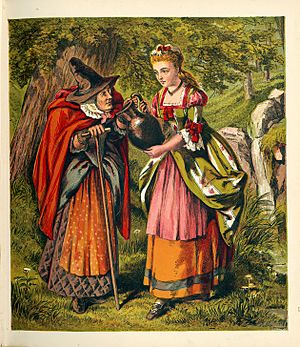
In 1871, she joined the Slade School of Fine Art. The headmaster, Edward Poynter, encouraged students to be more expressive and creative. This was a new idea for Kate, who had spent years just copying designs. She found it challenging and was also frustrated that women were separated from men in the life drawing classes.
Even while still in school, Kate started getting jobs illustrating children's books. Her first job was in 1867 for a book called Infant Amusements. This set her on the path to specializing in children's books. Her reputation grew because of the awards she won in her art courses and her early art shows. In 1868, she sold some fairy tale watercolors to a publisher, who then printed them in his magazine. A year later, Frederick Warne & Co bought six of her illustrations for a children's book called "Diamonds and Toads". In 1871, she illustrated a book of fairy tales by Madame d'Aulnoy. That year, she earned over 70 pounds from her work, which was a good amount of money then.
Kate realized that some of her early printed work looked too bright or "gaudy." This was partly because she didn't fully understand the Chromoxylography printing process. To learn more about color and printing, she often visited the National Gallery. There, she studied famous painters like Jan van Eyck. She also visited the British Museum to study illuminated manuscripts, which are old, beautifully decorated books.
Becoming a Freelance Artist
As Kate finished her art training, a new and profitable market for greeting cards was growing. Greeting cards first appeared in the 1840s, and by the 1860s, they were hugely popular. In 1871, a card company called Marcus Ward & Co hired Kate as a freelance artist. This company was known for its high-quality work.
Kate's designs sold very well. The company noted that her special talent was in drawing "costume figures and dainty colours." Her early Valentine's Day cards sold 25,000 copies in just a few weeks!
Under the Window and Later Life
Her first book, Under the Window (1879), was a collection of simple, charming poems about children. It quickly became a bestseller.

In the 1880s, Kate Greenaway was one of the most popular designers of bookplates (small printed labels for books). Her work, along with that of Walter Crane and Aubrey Beardsley, often featured detailed Art Nouveau designs with flowing lines and flower patterns.
In 1889, Kate was chosen to be a member of the Royal Institute of Painters in Water Colours. She also showed her work at the Palace of Fine Arts during the 1893 World's Columbian Exposition in Chicago, Illinois. She lived in a beautiful Arts and Crafts style house in Frognal, London, which was designed for her by Richard Norman Shaw. She still spent her summers in Rolleston.
Kate Greenaway passed away in 1901, at the age of 55. She is buried in Hampstead Cemetery, London.
Kate Greenaway's Unique Style
Kate Greenaway's illustrations were printed using a method called chromoxylography. This process used hand-engraved wood blocks to print colors. The firm of Edmund Evans did this printing. Throughout the 1880s and 1890s, her only main competitors in children's book illustration were Walter Crane and Randolph Caldecott.
The "Kate Greenaway" children in her pictures were usually young boys and girls. They wore her own versions of late 18th-century and Regency fashions. Boys wore smock-frocks and skeleton suits. Girls wore high-waisted pinafores and dresses with mobcaps and straw bonnets. She might have been inspired by the children's clothes in portraits by British painter John Hoppner.
The department store Liberty of London even turned Kate Greenaway's drawings into real children's clothes. For a whole generation, many mothers in artistic British circles dressed their daughters in Kate Greenaway-inspired outfits in the 1880s and 1890s.
Lasting Legacy
The Kate Greenaway Medal was created in her honor in 1955. It is given out every year in the UK by the Chartered Institute of Library and Information Professionals to the best illustrator of children's books.
Books Illustrated by Kate Greenaway
- Kingston, William, Infant Amusements, or How to Make a Nursery Happy, 1867.
- Aulnoy, Marie, Madame D'Aulnoy's Fairy Tales, 9 v., Gall and Inglis, 1871.
- Aunt Louisa's London Toy Books: Diamonds and Toads, Warne, 1871.
- Jeune, Margaret S., My School Days in Paris, London, Griffith and Farran, 1871.
- Knox, Kathleen, Fairy Gifts; or, A Wallet of Wonders, Griffith & Farran, 1874.
- Aunt Cae, The Children of the Parsonage, Griffith & Farran, 1874.
- Mulholland, Rosa, Puck and Blossom, Marcus Ward, 1874.
- Hill, Miranda, The Fairy Spinner, Marcus Ward, 1874.
- Jerrold, Alice, A Cruise in the Acorn, London, Marcus Ward, 1875.
- Clark, Mary Senior, Turnaside Cottage, London, Marcus Ward, 1875.
- Potter, Frederick Scarlett, Melcomb Manor: A Family Chronicle, London, Marcus Ward, 1875.
- Children’s Songs, London, Marcus Ward, c. 1875.
- Knox, Kathleen, Seven Birthdays; or, The Children of Fortune, Griffith & Farran, 1875.
- 'Quiver of Love, a Collection of Valentines' (with Walter Crane), Marcus Ward, 1876.
- LaBlanche, Fanny, Starlight Stories Told to Bright Eyes and Listening Ears, Griffith & Farran, 1877.
- Russell, Rutherford, Tom Seven Years Old, London, Marcus Ward, 1877.
- Hunt, Mrs. Bonavia, Poor Nelly, London, Cassell, Petter, Gilpin, 1878.
- Campbell, Lady Colin, Topo: A Tale About English Children in Italy, Marcus Ward, 1878.
- Yonge, Charlotte Mary, Heartsease; or The Brother’s Wife, Macmillan, 1879.
- Yonge, Charlotte Mary, The Heir of Redclyffe, Macmillan, 1879.
- Pollock, Walter Herries, Amateur Theatricals, London, Macmillan, 1879.
- Toyland, Trot’s Journey and Other Poems and Stories, New York, R. Worthington, c. 1879
- Weatherly, George, The “Little Folks” Painting Book, Cassell, Petter, Gilpin, 1879.
- Weatherly, George, The “Little Folks” Nature Painting Book, Cassell, Petter, Gilpin 1879.
- A Favorite Album of Fun and Fancy, London, Cassell, Petter, Gilpin, c. 1879.
- Haile, Ellen, Three Brown Boys and Other Happy Children, New York, Cassell & Co., c. 1879.
- Haile, Ellen, The Two Gray Girls and Their Opposite Neighbours, New York, Cassell & Co., c. 1879.
- Under the Window, London, George Routledge, 1879. Engraved and colour printed by Edmund Evans.
- Barker, Mrs. Sale, Kate Greenaway's Birthday Book, London, George Routledge, 1880. Engraved and colour printed by Edmund Evans.
- Freddie’s Letter: Stories For Little People, London, Routledge, 1880.
- The Old Farm Gate, London, George Routledge, c. 1880.
- Lang, Andrew, The Library, London, Macmillan and Company, 1881.
- Locker, Frederick, London Lyrics, London, Macmillan and Company, 1881.
- Mother Goose; or, The Old Nursery Rhymes, London, Routledge, 1881. Engraved and colour printed by Edmund Evans.
- Foster, Myles Burkett, A Day in a Child’s Life, London, Routledge, 1882. Engraved and colour printed by Edmund Evans.
- Ranking, Montgomerie and Tully, Thomas K., Flowers and Fancies; Valentines Ancient and Modern, Marcus Ward, 1882.
- Weatherly, F. E., The Illustrated Children’s Birthday Book (with others), London, W. Mack, 1882.
- Taylor, Ann and Jane, Little Ann and Other Poems, London, Routledge, 1883. Engraved and colour printed by Edmund Evans.
- Zimmern, Helen, Tales from the Edda, London, Sonnenschein, 1883.
- Language of Flowers, London, Routledge, 1884. Engraved and colour printed by Edmund Evans.
- A Painting Book By Kate Greenaway, London, George Routledge, 1884. Engraved and colour printed by Edmund Evans.
- Ellice, Robert, compiler, Songs for the Nursery: A Collection of Children’s Poems, Old and New, W. Mack, 1884.
- Kate Greenaway’s Christmas Carols, London: George Routledge, c. 1884.
- Kate Greenaway's Alphabet, London, Routledge, 1885. Engraved and colour printed by Edmund Evans.
- Kate Greenaway's Album, London, Routledge, c. 1885. Engraved and colour printed by Edmund Evans. (only eight copies were printed)
- Marigold Garden: Pictures and Rhymes, London, Routledge, 1885. Engraved and colour printed by Edmund Evans.
- Mavor, William, English Spelling Book, London, Routledge, 1885. Engraved and colour printed by Edmund Evans.
- Ruskin, John, editor, 'Dame Wiggins of Lee and Her Seven Wonderful Cats, London, George Allen, 1885.
- A Apple Pie: An Old-Fashioned Alphabet Book, London, Routledge, 1886. Engraved and colour printed by Edmund Evans.
- Harte, Bret, The Queen of the Pirate Isle, Chatto & Windus, 1886. Engraved and colour printed by Edmund Evans.
- Baby's Birthday Book, London, Marcus Ward, 1886.
- Allingham, William, Rhymes for the Young Folk, Cassell and Co., 1887. Engraved and colour printed by Edmund Evans.
- Queen Victoria's Jubilee Garland, London, George Routledge, 1887. Engraved and colour printed by Edmund Evans.
- Browning, Robert, The Pied Piper of Hamelin, London, Routledge, 1888. Engraved and colour printed by Edmund Evans.
- Around the House, New York, Worthington, 1888.
- Kate Greenaway's Book of Games, London, Routledge, 1889. Engraved and colour printed by Edmund Evans.
- Cresswell, Beatrice F., The Royal Progress of King Pepito, London, Society for Promoting Christian Knowledge, 1889. Engraved and colour printed by Edmund Evans.
- Arnim, Mary Annette, The April Baby's Book of Tunes, London and New York, Macmillan, 1900. The first use of colour-lithography on any of Kate’s Books.
- Spielmann, Mabel H., Littledom Castle and Other Tales (with others), London, George Routledge, 1903.
- Dobson, Austin, De Libris Prose and Verse (with others), London, Macmillan, 1908, 1911.
- Almanack, London, Routledge, 1883–1895. Engraved and colour printed by Edmund Evans.
Gallery
-
Polly from The Queen of the Pirate Isle, by Bret Harte
-
Greenaway's illustration of the Pied Piper leading the children out of Hamelin, to Robert Browning's version of the tale. Engraving by Edmund Evans.
-
A apple pie: An Old-Fashioned Alphabet Book
See also
 In Spanish: Kate Greenaway para niños
In Spanish: Kate Greenaway para niños



